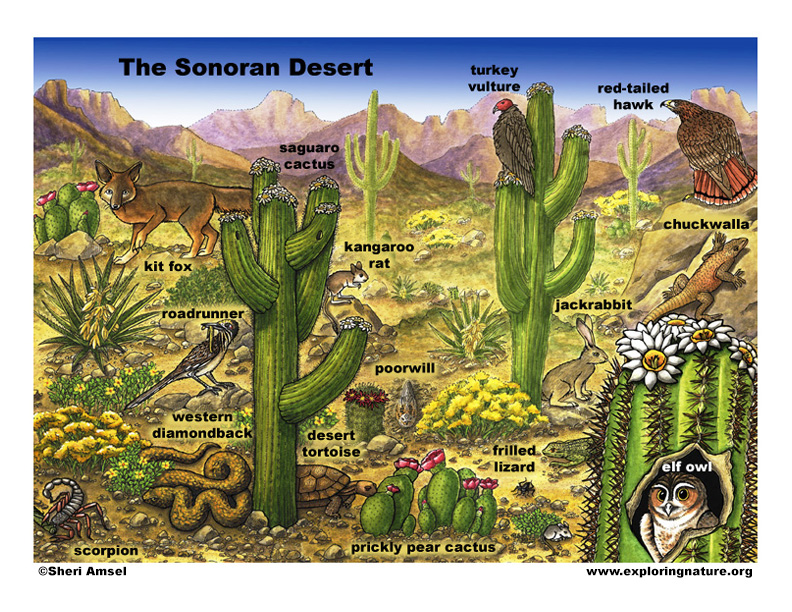

When you think of deserts, do you think of a dry, hot endless sea of sand, with no life? It is true that deserts are dry, and during the day it can be 100 degrees. Sometimes the ground can be too hot to walk on, even with shoes. At midday the scorching sun burns overhead making a shimmer of heat rise from the rocks and sand. But at night the desert can be cold! The temperature can drop well below freezing. Still most deserts are actually full of life. To live in a desert, however, plants and animals have to have many special tricks, or adaptations, to survive the big changes in temperatures and the lack of water.
Deserts can get rain, but not very often and not always enough to soak the ground. Sometimes a sudden heavy rain will fall and cause flash floods. A very dry riverbed can become a rushing river in only a few minutes. On the other hand, some of the world’s deserts wait years and years for a rainfall. In the Atacama Desert in South America, there has never been a rainfall on record.
Every year the world’s deserts are growing. Water is what decides whether an area is a dry grassland or a desert. Many grasslands live on just a few more inches of rainfall every year than a nearby desert. A change in rainfall can push a grassland into more of a desert. That is what has happened to many grasslands where people let their farm animals eat too much of the grass and shrubs. This is called overgrazing. The roots of the plants and grasses hold the water and keep the soil stable. When they are eaten away, the topsoil dries up and is blown or washed away. The land becomes a desert. This is called desertification and is a growing concern.
Rainfall brings a sudden bloom of desert life. Some plants quickly flower and make new seeds. Then the seeds harden and wait out the next long dry spell (drought). With new plant life to eat, animals will have more babies. Most animals in the desert are active at night. They are nocturnal. They also hunt for food in the early morning before it gets too hot. Then they go underground where it is cooler for the day. Desert life grows with rain, only to die back again as the water dries up and no new rain falls.
Humans can have a profound effect on dersert habitats. As human numbers grow, the need for space and resources has sent developers into the desert more and more. Minerals and oil are mined, and if the land is not too dry, it is often irrigated and farmed. Animals are collected for sale as pets or hunted as food. So even land that would seem protected by its own harsh ways, can be destroyed by humans. As with all natural habitats, the desert needs protection too.
When you research information you must cite the reference. Citing for websites is different from citing from books, magazines and periodicals. The style of citing shown here is from the MLA Style Citations (Modern Language Association).
When citing a WEBSITE the general format is as follows.
Author Last Name, First Name(s). "Title: Subtitle of Part of Web Page, if appropriate." Title: Subtitle: Section of Page if appropriate. Sponsoring/Publishing Agency, If Given. Additional significant descriptive information. Date of Electronic Publication or other Date, such as Last Updated. Day Month Year of access < URL >.
Amsel, Sheri. "About Deserts" Exploring Nature Educational Resource ©2005-2024. December 13, 2024
< http://www.exploringnature.org/db/view/About-Deserts >

